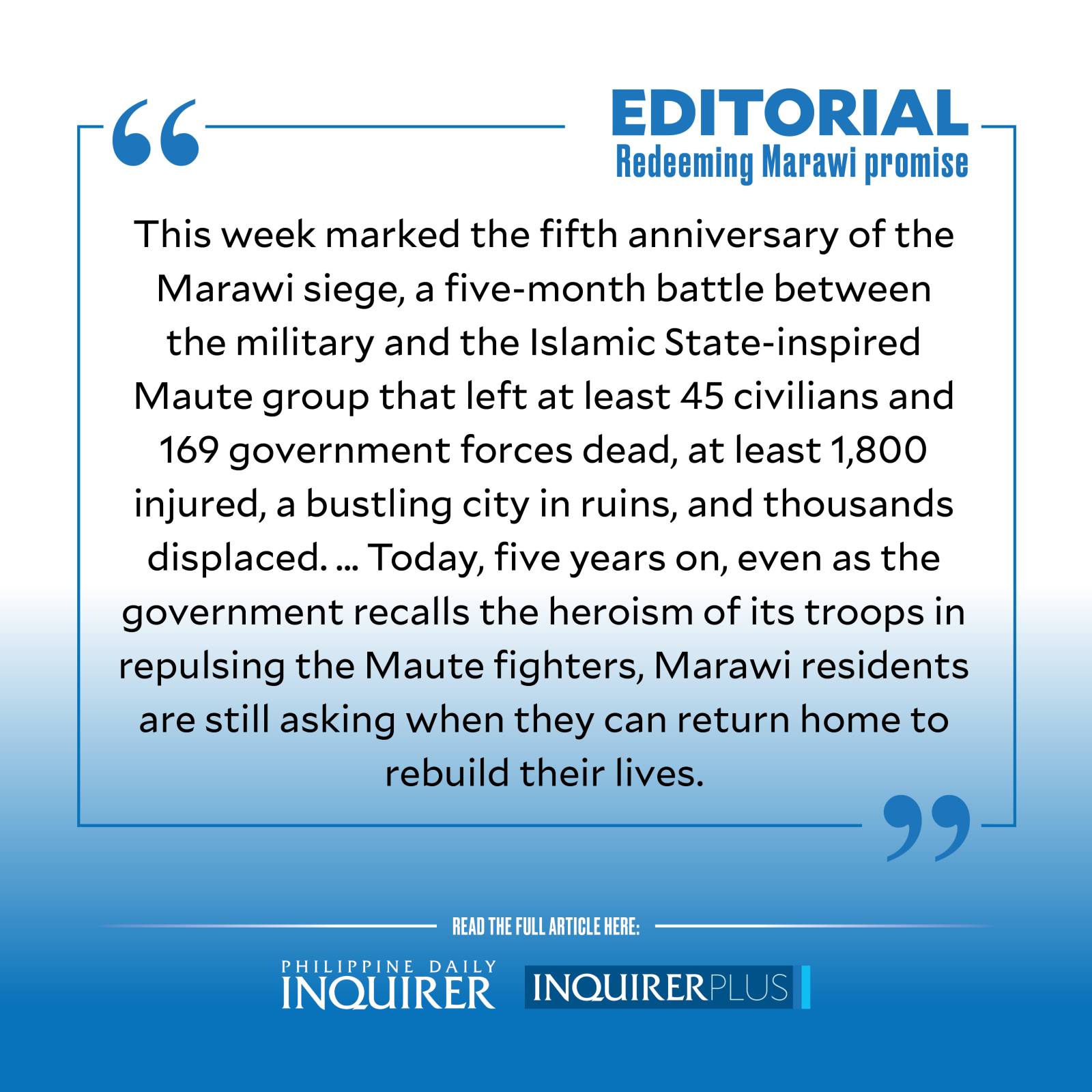Redeeming Marawi promise
This week marked the fifth anniversary of the Marawi siege, a five-month battle between the military and the Islamic State-inspired Maute group that left at least 45 civilians and 169 government forces dead, at least 1,800 injured, a bustling city in ruins, and thousands displaced.
The siege started on May 23, 2017, when government forces tried to arrest top leader Isnilon Hapilon of ISIL (the Islamic State of Iraq and the Levant group), with the renegade group invading Marawi City in Lanao del Sur and turning it into a war zone. In October 2017, government forces declared victory over the militants, and promised to rehabilitate the capitol city.
Today, five years on, even as the government recalls the heroism of its troops in repulsing the Maute fighters, Marawi residents are still asking when they can return home to rebuild their lives.
According to the Asian Development Bank, the estimated cost of damage to public and private property, as of August 2018, was about P11.5 billion, with an additional P7 billion in losses. The United Nations High Commissioner for Refugees (UNHCR), meanwhile, said that the confrontation displaced 98 percent (or more than 120,000) of Marawi’s population, who had to flee to evacuation centers, where most of them are still sheltered. As of August this year, the UNHCR counted 16,749 displaced families, while the April 2022 report of Task Force Bangon Marawi (TFBM) put the figure at 17,793 families from ground zero.
Out of some 2,700 applications to rebuild their homes, the local government of Marawi said it had issued permits to barely half, or 1,201. Only 95 homes have been restored while 361 are still being built.
Whatever happened to the almost $7 billion (or P350 billion) in Marawi funds from foreign donors, as well as those leftover from donations for Typhoon “Yolanda”?, people have asked.
Former housing secretary and TFBM head Eduardo del Rosario said only P10.7 billion of the received foreign assistance were channeled through the national government, with the rest—including in-kind donations—going to nongovernment and private organizations. Still, given the generous resources and limited work done in five years, a thorough and transparent accounting should be in order to ensure that the funds are maximized for their intended use.
To be fair, the challenges of rebuilding Marawi are formidable. In earlier reports, government officials have attributed the delay in construction and rebuilding to concerns about unexploded ordnance, with parts of the city and ground zero remaining closed. Then there are the land disputes, with several claimants fighting over lots, and the difficulty of installing power and water lines, essential services that would facilitate the city’s return to normalcy. As it is, with most public infrastructure restored but houses still in ruins, Marawi has the air of a ghost town with empty streets shrouded in darkness.
The rehabilitation that TFBM officials had projected would be 90 percent done before President Duterte stepped down in June, is at 72 percent construction level at most. The first quarter of 2023 has been targeted as the new date for completion.
A good way to fast-track Marawi’s rehabilitation is to operationalize Republic Act No. 11696, the Marawi Siege Victims Compensation Act that Duterte signed in April. The law allocates P1 billion as initial budget for compensation for those internally displaced by the conflict, and mandates the creation of a nine-member board that will determine the amount of compensation to be distributed. To date, the members of the board—who are expected to draw up the law’s implementing rules and regulations—have yet to be appointed. True, government functionaries have already started interviewing the affected residents, but can the budget trickle down to frontline agencies and local government units without the board’s authority?
In a recent statement, Surigao del Sur Rep. Johnny Pimentel said “the item is lodged in the P31-billion calamity fund for next year,” and, among other uses, will compensate residential and commercial property owners in Marawi whose structures were destroyed or damaged in the siege, or whose properties were demolished as part of the Marawi Recovery, Rehabilitation and Reconstruction Program.
Unfortunately, rebuilding Marawi seems to be of least priority to President Marcos Jr. who, during his campaign in March, said that there would be “no need” to focus on rehabilitating areas ravaged by war because Duterte was already “finishing it.” It may be time for the President to walk back his talk, and embrace the fact that he is the leader of an entire nation, including its often overlooked Muslim population whose neglected plight has fed a protracted and costly conflict with authorities.
Five years on, with the government honoring its fallen troops, shouldn’t it accord the same respect to those felled by the Marawi siege? A good start would be to constitute the compensation board posthaste to finally give the displaced residents the resources they need to rebuild their lives.

















